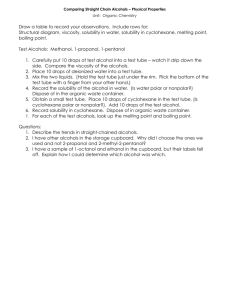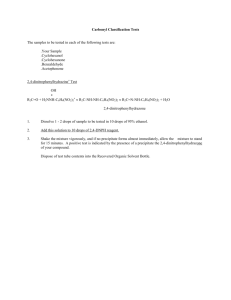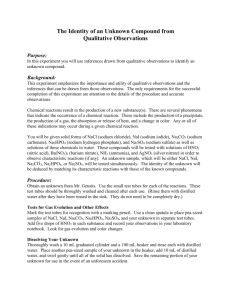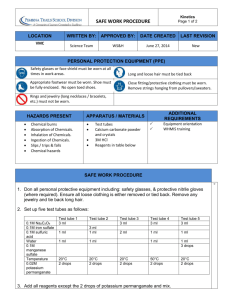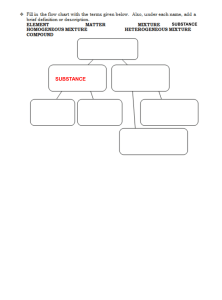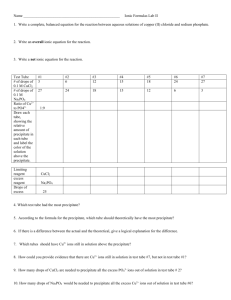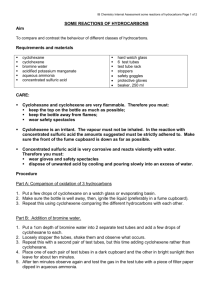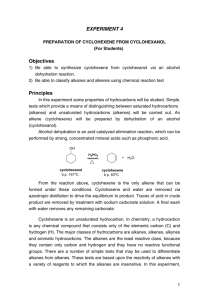Identification of an unknown Organic Compound Practicum 04.doc
advertisement
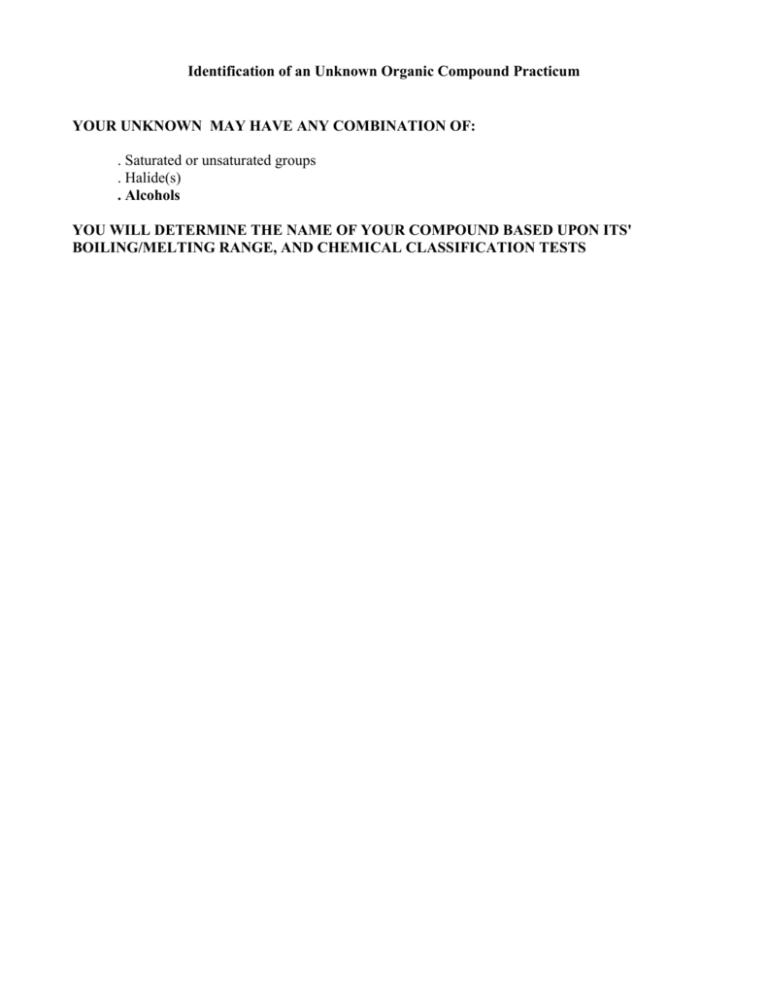
Identification of an Unknown Organic Compound Practicum YOUR UNKNOWN MAY HAVE ANY COMBINATION OF: . Saturated or unsaturated groups . Halide(s) . Alcohols YOU WILL DETERMINE THE NAME OF YOUR COMPOUND BASED UPON ITS' BOILING/MELTING RANGE, AND CHEMICAL CLASSIFICATION TESTS Alkyl Halide Classification Tests ALCOHOLIC SILVER NITRATE TEST: Add 1 drop, or a tiny amount of solid sample to 20 drops of a 0.1M solution of silver nitrate in 95% ethanol. If no reaction is observed within five minutes at room temperature, warm the mixture in a beaker of boiling water (using your hot plate and adding boiling chips to the bath), and observe any change. Note the color of any precipitates; silver chloride is white, silver bromide is pale yellow, and silver iodide is yellow. If there is any precipitate, add several drops of 1M nitric acid solution to it, and note any changes; the silver halides are insoluble in acid. To determine the expected reactivities, test the known halides provided. Dispose of test tube contents into the Silver Recovery bottle. Failure to do so will result in a 2 point deduction from your practicum score Record observations and conclusions in the Results portion of your lab report B. SODIUM IODIDE IN ACETONE TEST: Place 20 drops of the sodium iodide in acetone test solution in a test tube, and add 2 drops or a small amount of solid unknown. Cover and shake the test tube. Allow the tube to stand for 3 minutes and observe the formation of any precipitate. If no precipitate has formed, heat the tube in a bath of 50oC water (hot plate) for 6 minutes, then allow it to cool to room temperature. If a precipitate has formed, shake the contents of the tube. If the precipitate is still present after shaking the test tube and allowing it to stand at room temperature for 3 minutes, the test is positive. Carry this reaction out on all samples provided, including your unknown. Note in all cases the differences in reactivity as evidenced by the rate of formation of sodium bromide, chloride, or iodide. Dispose of test tube contents into the Recovered Organic Solvents bottle. Failure to do so will result in a 2 point deduction from your practicum score Record observations and conclusions in the Results portion of your lab report Alkene Classification Tests A. BROMINE IN CARBON TETRACHLORIDE TEST: To three CLEAN, DRY test tubes, add 20 drops ( or a tiny amount of solid ) of: a) cyclohexane b) cyclohexene c) your unknown Add 1 or 2 drops 0.1M Bromine in CCl4. Rapid disappearance of the bromine color to give a colorless solution is a positive test for unsaturation. Dispose of the test tubes contents into the Recovered Organic Solvent bottle . Failure to do so will result in a 2 point deduction from your practicum score Record observations and conclusions in the Results portion of your lab report B. THE BAER TEST: In a test tube, dissolve 1 or 2 drops of cyclohexane in 20 drops 95% ethanol, then add 0.1M potassium permanganate solution drop-wise, swirling the test tube from time to time, and observing the results. Count the number of drops added before the purple permanganate color persists. (To test for permanganate color; with your stirring rod, place a drop of solution from your test tube onto a piece of filter paper. The appearance of a purple ring around the outer edge of your spot indicates the presence of permanganate.) Repeat this process with cyclohexene, and your unknown. A significant difference in the number of drops used in your cyclohexane test versus the number used in your cyclohexene and unknown tests constitutes a positive test for un-saturation. Dispose of the test tubes contents into the Recovered Organic Solvents bottle. Failure to do so will result in a 2 point deduction from your practcum score Record observations and conclusions in the Results portion of your lab report Alcohol Classification Tests Perform the following tests on the known primary, secondary and tertiary alcohols provided, and your unknown. Primary and secondary alcohols give a positive test within 5 seconds. CHROMIC ACID IN ACETONE TEST: H2CrO4 Primary alcohols and aldehydes: RCH2OH ------------> RCO2H H2CrO4 H2CrO4 Secondary alcohols and aldehydes: R2CHOH ------------> R2CO ----------> no visible reaction Ketones do not react, BUT, Aldehydes do. H2CrO4 Tertiary alcohols and aldehydes: R3COH ----------> no visible reaction Dissolve 1 drop ( or a tiny amount of solid ) to be tested in 20 drops of acetone. Add 1 drop of chromic acid reagent and shake the tube to mix the contents. A positive reaction is indicated by the disappearance of orange color and formation of a green or blue-green precipitate. Color changes occurring after one minute should not be construed as a positive test. (why ?). Dispose of the contents of your test tubes into the "Recovered Organic Solvent" bottle. Failure to do so will result in a 2 point deduction from your practcum score Record observations and conclusions in the Results portion of your Lab Report in tabular form as follows: Compound Name Chromic acid test results Lucas test results LUCAS TEST: R3COH + HCl + Zn(Cl)2 ---> R3CCl + H2O To each of 4 test tubes, add 8 drops of the primary, secondary, and tertiary known alcohols, and, your unknown, respectively. ( If your unknown is a solid, add enough to cover the bottom of the test tube. ) Add 40 drops of Lucas reagent to each tube. Stopper the tubes and shake. Allow the tubes to stand at room temperature, noting the time required for the formation of an alkyl chloride, which will appear as an emulsion. Stir the contents of the test tubes into 800 mL of water that you have added to your 1L beaker, and subsequently dump the beakers contents down the sink. Return in the remainder of your Unknown to its’ container and leave the container at your lab bench. Failure to do so will result in a 10 point deduction from your practcum score. Table of Possible Unknown Compounds Su’04 2-methyl-1,3-butadiene pentane 1-chloro-1-propene bromoethane cyclopentene cyclopentane methylpentene 2,3-dimethylbutane 2-bromopropane 1-hexene Methanol 1-chloro-2-methylpropane hexane 2-chlorobutane 3-bromo-1-propene 1-bromopropane 2-bromo-2-methylpropane 1-chlorobutane Ethanol cyclohexane cyclohexene 2-chloro-2-methylbutane 2-bromobutane 1-bromo-2-methylpropane 2-propene-1-ol 1-propanol heptane 2-methyl-3-butene-2-ol 1-bromobutane 34oC 35oC 37oC 38oC 45oC 50oC 54oC 58oC 59oC 64oC 65oC 68oC 69oC 69oC 71oC 71oC 73oC 78oC 78oC 81oC 83oC 85oC 91oC 91oC 97oC 97oC 98oC 98oC 102oC 3-Methyl-2-butanol 3-bromopentane 2-pentanol 1-bromo-3-methylbutane 1-octene 3,4-dichloro-1-butene Octane 2-methyl-1-butanol 2-chloroethanol 1-bromopentane 3-methyl-3-butene-1-ol 1-chlorohexane 1-pentanol cyclopentanol chlorocyclohexane cyclooctene 1-bromohexane 1-chloroheptane cyclohexanol bromocyclohexane decene Decane 1-bromoheptane 2-octanol 1-octanol undecane 1-bromooctane hexachloropropene 1-decanol 1-bromodecane 114oC 119oC 120oC 120oC 121oC 123oC 126oC 129oC 130oC 130oC 131oC 134oC 138oC 141oC 142oC 145oC 158oC 160oC 161oC 165oC 171oC 174oC 177oC 179oC 195oC 196oC 201oC 209oC 231oC 241oC Che 301 Su’2004 Lab Report Title: Identification of an Unknown Organic Compound Name: Unknown #: Date: Boiling/Melting Range: You determined your unknown to be , based upon the following: Tests Performed None Halide Tests AgNO3 Detailed rationale for your Selection: NaI Alkene Tests Br2/CCl4 KMnO4 Alcohol Tests Chromic Lucas Test: Alcoholic AgNO3 Equation: What indicates a positive test: How can the halides be distinguished from one another ? Known Halides Results / Observations 1-Bromobutane 1-Chlorobutane 2-Bromobutane 2-Chlorobutane 2-Bromo-2-methylpropane 2-Chloro-2-methylpropane Unknown Results / Observations Conclusions: Your Unknown behaved similarly to which known(s) ? Test: NaI in Acetone Equation: What indicates a positive test: How can the halides be distinguished from one another ? Known Halides Results / Observations 1-Bromobutane 1-Chlorobutane 2-Bromobutane 2-Chlorobutane 2-Bromo-2-methylpropane 2-Chloro-2-methylpropane Unknown Results / Observations Conclusions: Your Unknown behaved similarly to which known(s) ? Test: Bromine in CCl4 Equation: What indicates a positive test: Known Compounds Results / Observations Cyclohexane Cyclohexene Unknown Results / Observations Conclusions: Your Unknown behaved similarly to which known(s) ? Test: 0.1M KMnO4 Equation: What indicates a positive test: Known Compounds Results / Observations Cyclohexane Cyclohexene Unknown Results / Observations Conclusions: Your Unknown behaved similarly to which known(s) ? Alcohol Classification Tests Compound Name Chromic acid test results Lucas test results Conclusions: Your Unknown behaved similarly to which known(s) ?
